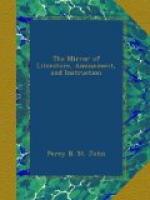Sir Lumley St. George Skeffington was the dandy of the olden time, and a kinder, better-hearted man, never existed. He is a person of some taste in literature, and of polished manners, nor has his long intercourse with fashionable society at all affected that simplicity of character for which he has been remarkable. He was a true dandy: and much more than, that, he was a perfect gentleman. I remember, long long since, entering Covent Garden Theatre, when I observed a person holding the door to let me pass; deeming him to be one of the box-keepers, I was about to nod my thanks: when I found, to my surprise, that it was Skeffington, who had thus goodnaturedly honoured a stranger by his attention. We with some difficulty obtained seats in a box, and I was indebted to accident for one of the most agreeable evenings I remember to have passed.
I remember visiting the Opera, when late dinners were the rage, and the hour of refection was carried far into the night. I was again placed near the fugleman of fashion (for to his movements were all eyes directed: and his sanction determined the accuracy of all conduct). He bowed from box to box, until recognising one of his friends in the lower tier, “Temple,” he exclaimed, drawling out his weary words, “at—what—hour—do—you—dine—to-day?” It had gone half-past eleven when he spoke!
I saw him once enter St. James’s Church, having at the door taken a ponderous red-morocco prayer-book from his servant; but, although prominently placed in the centre aisle, the pew-opener never offered him a seat; and, stranger still, none of his many friends beckoned him to a place. Others, in his rank of life, might have been disconcerted at the position in which he was placed: but Skeffington was too much of a gentleman to be in any way disturbed; so he seated himself upon the bench between two aged female paupers, and most reverently did he go through the service, sharing with the ladies his book, the print of which was more favourable to their devotions than their own diminutive Liturgies.
New Monthly Magazine.
* * * * *
MARQUESS OF CLEVELAND.
In the Gazette of September 17, 1827, is registered the grant of the title of Marquess of Cleveland to the Earl of Darlington.
The noble Earl probably selected the title of “Cleveland” in consequence of his representing the extinct Dukes of Cleveland. King Charles the Second, on the 3rd of August, 1670, created his mistress, Barbara Villiers, the daughter and heiress of William, second Viscount Grandison in Ireland, and wife of Roger Palmer, Earl of Castlemaine, Baroness Nonsuch, in the county of Surrey, Countess of Southampton, and Duchess of Cleveland, with remainder to two of her natural sons by the King, Charles Fitz Roy, and George Fitz Roy, who was created Duke of Northumberland in 1674,




